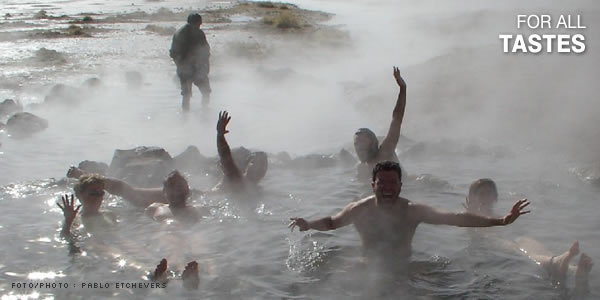
Due to its vast geography and wide range of climates, Argentina features a broad tradition of thermal tourism.
All along the Andes Mountain Range, most hot springs are the result of volcanic or mountainous activities. This huge mountain chain features large geographical faults and high geothermal activity, which accounts for the great deal of hot spring sources it possesses.
On the Argentinian side, the most outstanding hot springs due to their historical value are Termas de Reyes -which stands for "Kings' Hot Springs" in Spanish- (Jujuy), the most visited by local and foreign tourists year round; and Puente del Inca -which stands for "Inca's Bridge" in Spanish- (Mendoza), the most picturesque due to its hues; but also the Caviahue and Copahue hot springs (Neuquén), which feature volcanic origin, stand out.
The City of Termas de Río Hondo (Santiago del Estero), located on the Dulce River, is another traditional and popular hot spring resort visited by Argentinian tourists, especially by groups of senior citizens who come along lured by the healing benefits of its waters and the accommodation facilities. Here, hot spring waters lie near the surface; therefore, it is not necessary to drill too deep to find them.
But for the Province of Entre Ríos and neighboring Uruguay, everything changed after the Salto Grande hydroelectric dam was built on the shores of the Uruguay River, shared by both countries. During the drillings, some hot water layers were found. Though disregarded at the time, they would turn out quite useful for the local villages later on to exploit a new tourist attraction: hot spring waters.

Thus, the cities of Entre Ríos began giving shape to their own hot spring resorts: Federación (fresh water hot springs), Chajarí (with natural cascades and pools), Concordia (mineral drinkable waters), Colón (ideal to be drunk on an empty stomach and to relieve gastric disorders), Villa Elisa (saline water), Gualeguaychú (the closest to the Federal District) and La Paz (seawaters). Very expensive drillings were carried out in order to exploit a resource that had been waiting for millions of years. This treasure sprang up to the surface in the shape of freshwater, saline water or even seawater.
At the same latitude but on the Uruguayan side, identical findings were carried out. The Arapey and Dayman hot springs became known for the great quality of their waters as drinkable, stomach sedative and diuretic, in addition to their thermal qualities. The same occurred at the hot springs of Salto, today sheltered by the largest hot spring park in South America, with pools and activities suitable for all ages.
As we come close to the Atlantic Ocean, we get to the last successful drilling named Termas Marinas. At San Clemente del Tuyú (Province of Buenos Aires), just 300 kilometers away from the City of Buenos Aires, there lie the first hot spring waters on the Argentinian Atlantic Coast. These waters have turned out to be excellent for hydrotherapy and they bear three times more salts than seawaters.

© 2003-2025 Total or partial reproduction forbidden. Derechos de Autor 675246 Ley 11723
Who we are | Contact us | Press and Publicity | Terms and Conditions



